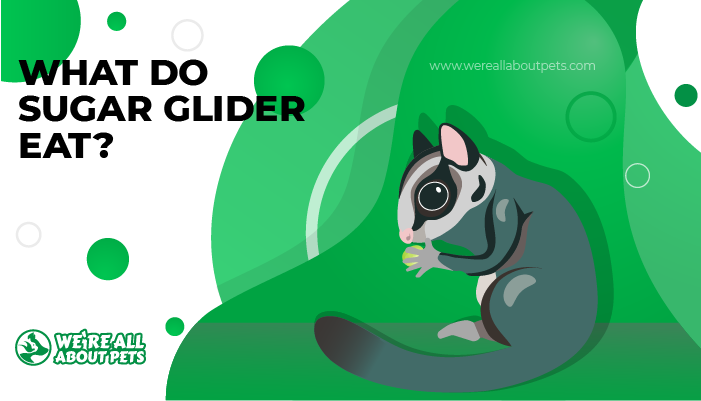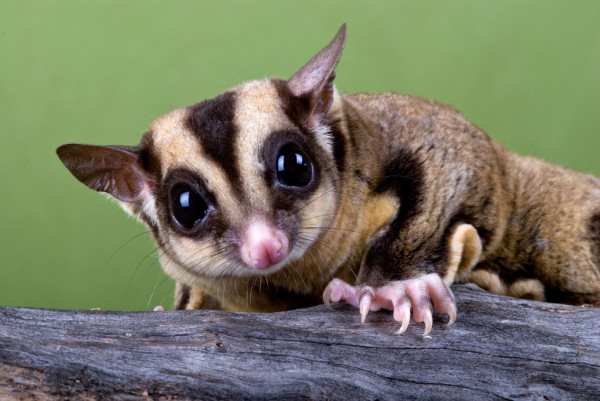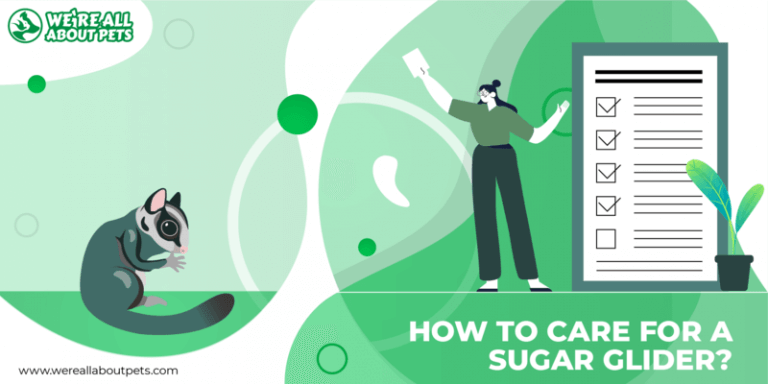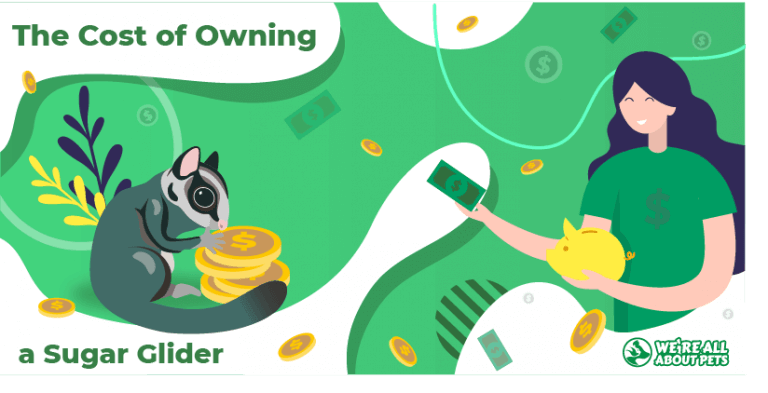What Do Sugar Gliders Eat?
This page contains affiliate links. We may earn money or products from the companies mentioned in this post through our independently chosen links, which earn us a commission. Learn More

If you’re looking for a cute, furry little pet, you might be considering a sugar glider. The sugar glider (Petaurus breviceps) is a small, tree-dwelling marsupial that is native to Australia, New Guinea, and some Indonesian islands.
This type of exotic pet is known for bonding closely with their human caretakers, but they definitely aren’t the right pet for everyone.
The sugar glider is not the kind of pet you’ll find in pet stores.
It’s an exotic animal and has complicated nutritional needs. In the wild, sugar gliders are opportunistic omnivores, meaning they eat a wide range of foods depending on what’s available.
Though they eat a variety of foods, pet sugar gliders require specific nutrients. It can be difficult to create a balanced diet for a sugar glider at home. The key to keeping your sugar glider healthy is to mimic his natural diet as much as possible.
Unfortunately, commercial sugar glider food may not be enough to completely provide for your sugar glider’s nutritional needs.
Without a varied diet that includes the right nutrients, your exotic pet could develop serious health problems. Read on to learn what foods are and are not safe for sugar gliders and learn more about what sugar gliders eat.
Quick Navigation
Safe and Unsafe Foods for Sugar Gliders

Because sugar gliders eat a variety of foods in the wild, there are many different things that you can feed them. The natural diet of a sugar glider consists of the gum and sap of the eucalyptus and acacia trees, along with pollen, nectar, fresh fruits, and insects.
Though sugar gliders can eat many different things, what’s really important is that you strike the right nutritional balance. Before we get into the details of a balanced diet for these marsupials, let’s take a quick look at the foods that are and aren’t safe.
Foods That Are Safe for Sugar Gliders:
- Commercial sugar glider food
- Leadbeater mixture
- Nectar
- Acacia gum
- Eucalyptus sap
- Bee pollen
- Apples
- Bananas
- Cantaloupe
- Grapes
- Kiwi
- Oranges
- Melons
- Papaya
- Blueberries
- Crickets
- Mealworms
- Earthworms
Foods That Sugar Gliders Can Eat in Moderation:
- Honey
- Boiled egg
- Cat food
- Dog food
- Unsalted nuts
- Lettuce
- Sweet potatoes
- Tomatoes
- Carrots
- Squash
- Broccoli
- Sweet corn
Foods That Are Not Recommended for Sugar Gliders:
- Raw sugar
- Sugar substitutes
- Candy
- Salted nuts
- Peanuts
- Wild-caught insects
- Processed food
Foods Toxic or Harmful for Sugar Gliders:
- Chocolate
- Dairy products
- Raspberries
- Strawberries
- Blackberries
- Spinach
- Beets
- Figs
- Collard greens
- Apple seeds
- Fruit pits
- Garlic
- Onions
- Rhubarb
Now that you have a better idea of what your sugar glider can eat, you may be wondering what he should eat. Read on to learn the basics of a healthy sugar glider diet and what you can do to make sure your pet’s nutritional needs are being met.
Types of Sugar Glider Diets
As an exotic pet, the sugar glider has unique nutritional needs that can’t be met with a bag of food that you pick up at the pet store.
The best feeding recommendations for these marsupials come from experts like Australian zookeepers and veterinarians.
They recommend a specific blend of foods, supplemented with fresh fruits and vegetables in small amounts.
Here is a quick breakdown of the different components of a pet sugar glider’s diet:
- Leadbeater’s Mix – A mixture of warm water, honey, boiled egg, baby cereal, and vitamin supplement. This should be fed in equal amounts to insects that you’ll feed to your sugar glider.
- Insects – Provide a variety of insects, ideally gut-loaded with healthy foods and dusted with a calcium supplement or multivitamin powder.
- Fresh Fruits – Your sugar glider can eat very small amounts of fresh fruits mixed together. Wash the fruits thoroughly to remove dirt.
In addition to these foods, sugar gliders can eat small amounts of vegetables. They tend to prefer sugary foods, however, so you may want to stick to things like sweet potatoes and sweet corn.
Avoid foods that are high in fat, like peanuts. Offer unsalted seeds, which can also be high in fat, only in small amounts. Avoid fruits and vegetables that are high in oxalates (e.g., raspberries, blackberries, spinach, beets, figs) because they may impair calcium absorption.
Meeting Your Sugar Glider’s Nutritional Needs
When it comes to sugar glider food, remember that no single food can meet your pet’s needs for a balanced diet. Commercial sugar glider pellets provide protein, healthy fats, carbohydrates, and essential nutrients. But, pet sugar gliders still need insects and a veterinarian-developed mixture called Leadbeater’s mix.
This mix consists of water, honey, boiled egg, high-protein baby cereal, and vitamin supplement. These ingredients are blended into a smooth liquid.
In addition to providing the right variety of foods for your sugar glider, pay attention to his diet’s vitamin and mineral content.
Sugar gliders are highly prone to metabolic bone disease that results from an improper ratio of calcium to phosphorus in their diet. If the diet is too high in phosphorus, the body will leach calcium from the bones to restore balance, leading to soft bones that are prone to injury.
Taking the time to properly balance your sugar glider’s diet is important. But, you may still need to include a multivitamin or calcium supplement to achieve that goal.
Baby sugar gliders, called joeys, have special nutritional needs. When joeys are first out of the pouch, they require frequent feeding with milk replacer if they can’t feed directly from the mother.
If you are feeding your joey, you’ll need to hand-feed him for at least 6 weeks, then start weaning him. After about 6 months, he should be ready to start accepting small amounts of dry pellets, in addition to Leadbeater’s mixture, insects, and small pieces of fresh fruits and veggies.
To give you an idea what sugar gliders eat and how much you should be feeding your pet sugar glider during different life stages, refer to this chart:
Daily Sugar Glider Feeding Chart |
||||
| Age | Pellets | Leadbeater’s Mixture | Insects | Fruits and Veggies |
| Up to 6 weeks | Mother’s milk only or milk replacer (fully weaned by 8 weeks) | |||
| Up to 6 months | None | 75% of diet along with insects | Along with Leadbeater’s mix | 25% of diet, chopped |
| 6 months and up | 1 tablespoon
(about 1/3 of diet) |
1 tablespoon
(about 1/3 of diet) |
1 tablespoon (about 1/3 of diet) | Very small amounts, finely chopped |
In addition to providing the food your sugar glider needs for a balanced diet, you also need to make sure he stays hydrated. When your pet is still very young, a water dish may be the best option, but you can eventually teach your pet to use a water bottle. Just make sure that the water bottle is full of fresh water at all times, and that you clean and refill it once a day.
Recommended Commercial Sugar Glider Foods
As a pet owner, you are responsible for providing for your pet’s nutritional needs. The challenge with an exotic animal like the sugar glider is that you can’t simply buy a bag of food from the pet store. Commercial sugar glider diets do exist, but they need to be supplemented with other foods. Keep this in mind when shopping for sugar glider pellets.
Here are some of our top picks for the best commercial sugar glider food:
- Mazuri Insectivore Diet – This recipe is formulated for a wide variety of insectivores including sugar gliders, so it’s high in protein and fiber. If you’re looking for an alternative to feeding your sugar glider live insects, this may be a good option.
- Exotic Nutrition Glider Complete – Made with 100% natural ingredients and no artificial additives, this high-protein commercial pellet is fortified with vitamins and minerals. It also contains chunks of dried fruit, including papaya, pears, golden raisins, blueberries, and apples.
- Vitakraft Vitasmart Sugar Glider Food – This high-protein formula is made with plenty of protein and essential vitamins and minerals to deliver balanced nutrition for your sugar glider. It contains dried fruit and supplemental omega-3 fatty acids. The fatty acids support healthy brain and heart function.
Looking for more information about keeping sugar gliders as pets? Check out our other sugar glider content on We’re All About Pets.
Frequently Asked Questions
What do sugar gliders eat in the wild?
Wild sugar gliders follow a natural diet of sap and gum from eucalyptus and acacia trees, along with bee pollen, nectar, manna, honeydew, and a variety of insects. Fruit is not a significant part of a wild sugar glider’s natural diet but is common in a captive sugar glider's diet.
How much do sugar gliders eat?
The sugar glider is very small, so these pets don’t need to eat a lot of once. It’s more about providing a balanced diet, which you can accomplish by feeding a combination of Leadbeater’s mix, commercial sugar glider pellets, and insects with small amounts of fresh fruits.
What do sugar gliders drink?
Sugar gliders drink water like any other animal. Most get used to using water bottles, though you may need to offer a water dish at first if your pet isn’t used to the bottle yet.
Do sugar gliders eat insects?
Yes. Insects are part of the sugar glider’s diet in the wild. When feeding insects in captivity, you should gut-load them first. This simply means feeding the insects healthy foods so the nutrients will be passed along to your sugar glider. You should also dust the insects with a calcium supplement or multivitamin powder.








